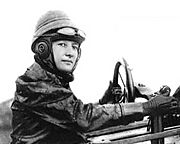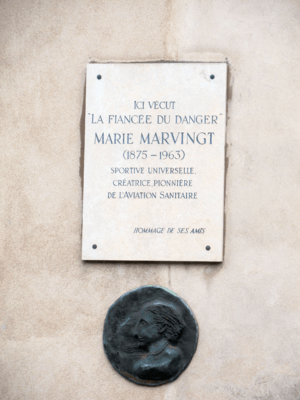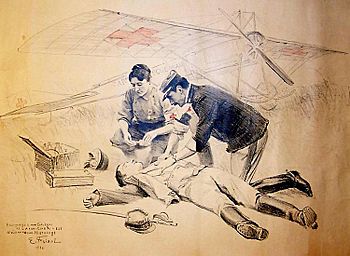Marie Marvingt facts for kids
Quick facts for kids
Marie Félicie Élisabeth Marvingt
|
|
|---|---|

Marie Marvingt in her Deperdussin aeroplane, 1912
|
|
| Born | 20 February 1875 |
| Died | 14 December 1963 (aged 88) Laxou, in Meurthe-et-Moselle, France
|
| Occupation | Athlete, mountaineer, aviator, nurse, journalist |
| Parent(s) | Mother, Élisabeth née Brusquin, (died 1889); Father, Félix Marvingt, died 1916. |
Marie Marvingt (born February 20, 1875 – died December 14, 1963) was an amazing French athlete, mountain climber, pilot, and journalist. She won many awards for her incredible achievements in sports. These included swimming, cycling, mountain climbing, and winter sports. She was also great at ballooning, flying, horse riding, gymnastics, and shooting.
Marie was the first woman to climb many peaks in the French and Swiss Alps. She set records in ballooning and flying airplanes. During World War I, she even became the first female combat pilot. Marie was also a trained surgical nurse. She was the first person in the world to be certified as a flight nurse. She worked hard to create air ambulance services around the globe. In 1903, someone called her "the fiancée of danger." Newspapers used this nickname for her throughout her life.
Contents
Biography
Early life
Marie Félicie Élisabeth Marvingt was born on February 20, 1875, in Aurillac, France. Her father, Félix Constant Marvingt, was a senior postmaster. Her mother was Élisabeth Brusquin. Before Marie was born, her parents had lost three baby sons.
The family, including her younger brother Eugène, lived in Metz, Germany, from 1880 to 1889. When Marie's mother died in 1889, Marie was just 14. She took charge of the household. The family then moved to Nancy, where Marie lived for the rest of her life.
Marie's father, Félix, was a local champion in billiards and swimming. He loved sports. Since his only son was often sick, he shared his love of sports with Marie. He encouraged her natural talents. By age four, she could swim 4 kilometers (about 2.5 miles)! She also loved many other sports. These included mountaineering, shooting, gymnastics, horse riding, and fencing. She also enjoyed skiing, ice skating, boxing, and even football. In 1890, at 15, she canoed over 400 kilometers (about 250 miles). This trip went from Nancy to Koblenz, Germany. She also learned circus skills and got a driver's license by 1899.
Sporting successes
Marie Marvingt became a world-class athlete. She won many awards in swimming, fencing, and shooting. She was also great at skiing, speed skating, and luge. She was a skilled mountaineer. Between 1903 and 1910, she was the first woman to climb most peaks in the French and Swiss Alps. This included climbing two difficult peaks near Chamonix in one day. In 1905, she became the first Frenchwoman to swim the entire length of the Seine River through Paris. Newspapers called her "the red amphibian" because of her red swimming costume.
In 1907, she won an international military shooting contest. She used a French army rifle. She was the only woman ever to receive the palms du Premier Tireur award. This award came from a French Minister of War. She was amazing in winter sports from 1908 to 1910. She won first place more than 20 times in places like Chamonix. On January 26, 1910, she won the Léon Auscher Cup. This was for the women's bobsledding world championship.
Marie loved cycling. She once rode her bike from Nancy, France, all the way to Naples, Italy. She wanted to see a volcanic eruption! In 1908, she was not allowed to join the Tour de France cycling race. This was because the race was only for men. But Marie decided to cycle the course anyway. She rode some distance behind the official racers. She finished the very tough ride successfully. Only 36 out of 114 male riders managed to finish that year. On March 15, 1910, the French Academy of Sports gave her a gold medal "for all sports." This was the only multi-sport medal they have ever given.
Achievements in early aviation
Ballooning
Marie Marvingt first flew as a passenger in a balloon in 1901. On July 19, 1907, she piloted one herself. On September 24, 1909, she made her first solo flight as a balloon pilot. Then, on October 26, 1909, Marie became the first woman to pilot a balloon across the North Sea. She flew from Europe to England in her balloon, The Shooting Star. She won prizes for ballooning in 1909, 1910, and 1911. On July 18, 1914, she was the first woman to cross the English Channel in a balloon. This was during the 10th Grand Prix of the French Air Club. She earned her balloon pilot's license (#145) in 1910. She was the second woman to do so.
Fixed-wing powered flight
In September 1909, Marie Marvingt flew for the first time as a passenger in an airplane. The pilot was Roger Sommer. In 1910, she learned to fly airplanes with Hubert Latham. He was a rival of Louis Blériot. She learned to fly an Antoinette airplane. This plane was known for being hard to fly. Marie was the first woman to pilot, fly solo, and pass her license tests in an Antoinette.
Marie Marvingt received her pilot's license from the Aéro-Club de France on November 8, 1910. Her license number was 281. She was the third Frenchwoman to get a pilot's license. In her first 900 flights, she never crashed her plane. This was an amazing record at that time.
Marie flew in many air shows. She even bombed a German airbase twice as an unofficial pilot in World War I. She also flew on missions in North Africa. Marie was the only woman to hold four pilot's licenses at the same time. These were for balloons, airplanes, seaplanes, and helicopters. When she was in her 80s, Marie even flew a jet-engined helicopter! She also renewed her pilot's license then.
Femina Cup
On November 27, 1910, Marie Marvingt set the world's first aviation records for women. These were for how long she stayed in the air and how far she flew. Before this, women's flight activities were not officially recorded. Marie insisted that her flight be officially timed and measured. She wanted to show that women should be included in the record books. She was also competing for the Femina Cup. This cup was offered by Pierre Lafitte, who owned the women's magazine Femina. The cup would go to the Frenchwoman who flew the longest nonstop flight by the end of 1910.
Marie made another flight that broke her own record. But on December 21, 1910, Hélène Dutrieu flew even farther. Hélène was also a cycling champion and the fourth woman in the world to get a pilot's license. Marie tried one last time to win the Cup on December 30, 1910. But her plane had a mechanical problem, and she had to land early. Hélène Dutrieu won the cup. The Femina Cup was important because it started official record-keeping for women in aviation. It also showed the world what women could do in the air.
Air ambulances
Marie Marvingt suggested using airplanes as air ambulances to the French government as early as 1910. She worked with Louis Béchereau, an engineer from the Deperdussin company. Together, they designed the first idea for a practical air ambulance. Marie gave many popular talks to raise money to buy one for the French military and the Red Cross. In 1912, she ordered an air ambulance from Deperdussin. But the company went bankrupt before it could be delivered.
Marie spent the rest of her long life working on the idea of aeromedical evacuation. This means using aircraft to transport sick or injured people. She gave over 3,000 talks and seminars about it on at least four continents. She helped start a French organization called Les Amies De L'Aviation Sanitaire (Friends of Medical Aviation). She also helped organize the first International Congress on Medical Aviation in 1929.
In 1931, she created the Challenge Capitaine-Écheman. This award gave a prize for the best civilian aircraft that could be turned into an air ambulance. In 1934, she started a civilian air ambulance service in Morocco. She received the Médaille de la Paix du Maroc (Medal of Peace of Morocco) for this work. In the same year, she created training courses for Infirmières de l'Air (Nurses of the Air). In 1935, she became the first person certified as a Flight Nurse. In 1934 and 1935, she wrote, directed, and appeared in two documentary films about air ambulances. These films were called Les Ailes qui Sauvent (The Wings That Save) and Sauvés par la Colombe (Saved by the Dove).
The Flying Ambulance Corps was a group of women pilots and nurses. Their goal was to rescue wounded soldiers on the battlefield using aircraft. They would land at special ground stations with medical teams. By 1939, this idea became very important again. Marie Marvingt had been working on these plans for almost 30 years. She visited the United States several times to talk with government officials. In France, important leaders like Marshals Foch supported her. Many young women were excited by her ideas. At the start of World War II, over 500 nurses with flying experience joined a new group of flying nurses. Some of them were also parachutists. On January 30, 1955, she received a big award from the French National Federation of Aeronautics. This was for her work in aviation medicine.
War activities
During World War I, Marie disguised herself as a man. With the help of a French officer, she served on the front lines as a soldier. She was discovered and sent home. But later, she took part in military operations with the Italian army in the Dolomites. This was at the direct request of Marshal Foch. She also worked as a Red Cross surgical nurse. She was a war reporter on the Italian front. She probably also gathered information for military leaders.
In 1915, Marie Marvingt became the first woman in the world to fly combat missions. She volunteered as a pilot and flew bombing missions over German territory. She received the Croix de guerre (Military Cross) for bombing a German military base in Metz. Between the two World Wars, she worked as a journalist and medical officer with French forces in North Africa. While in Morocco, she thought of using metal skis for air ambulances. This would allow them to land on desert sand. She even ran a ski school in the desert, teaching people to ski on sand dunes!
In World War II, she again worked as a Red Cross nurse. She continued to promote the ambulance-airplane idea. She also started and ran a home for wounded pilots. She fought in the French Resistance, a secret group fighting against the occupation. For this, she received a special medal. A plaque in Saint-Alvère, France, says: "Marie Marvingt, Resistance Fighter, Is Honored."
Death and posthumous recognition
Marie Marvingt passed away on December 14, 1963, at the age of 88. She died in Laxou, a small town in France. Her funeral was on December 17, and she is buried in the Cimetière de Préville in Nancy.
In France, many streets, gyms, schools, and flying clubs are named after her. In 1987, she was added to the International Women's Sports Hall of Fame. France even issued an airmail stamp in her honor on June 29, 2004. Several awards are given each year in her memory.
Works
Films
Marie Marvingt planned, produced, and acted in two films. These were Les Ailes qui Sauvent (The Wings That Save) in 1934 and Sauvés par la Colombe (Saved by the Dove) in 1935. She also found the filming locations in North Africa. She directed the filming from a plane flying next to the one with the camera! The first film has been saved in French military archives. The location of the second film is unknown.
Awards

Marie Marvingt received many honors, with over 34 decorations, awards, and medals. Some of them include:
- Legion of Honor: Chevalier (Knight) in 1935; Officier (Officer) in 1949
- Croix de Guerre 1914–1918 (Military Cross)
- Gold medal from the French Academy of Sports for being excellent in all sports (1910)
- Médaille de la Résistance (with a star) for her work in the Resistance during World War II
- Deutsch de la Meurthe grand prize for her work in aviation medicine (1955)
- Chevalier dans l'Ordre de la Santé publique (Knight of the Order of Public Health, 1937)
- Palms du Premier Tireur (First-Class Gunner)
- Coupe Léon Auscher (first international women's bobsledding championship)
- Médaille de la Paix du Maroc (Morocco's Peace Medal)
- Commandeur du Mérite Sportif
- Prix de l'Académie Stanislas
- Médaille d'or de la reconnaissance de l'aviation sanitaire
- Gold medal from the Académie Internationale des Sports
- Officier de l'instruction publique
- Palmes Académiques (Academic Palms)
- Médaille de l'Aéronautique (Aeronautics Medal)
- Médaille de la Ville de Nancy (Nancy's Medal of Honor, 1950)
- Médaille d'Argent du Service de Santé de l'Air (Air Force Medical Service's silver medal, 1957)
- Médaille d'Or de l'Éducation Physique (Gold Medal for Physical Education, 1957)
- Honorary diploma and bronze medal from the Ligue Aéronautique de France
- Named to the International Women's Sports Hall of Fame (1987)
- International literary prize in 1948 and 1949 from the Women's Aeronautical Association of Los Angeles
- Twenty gold medals in Winter Sports (1908, 1909, 1910)


